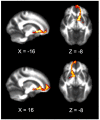Structural integrity of frontostriatal connections predicts longitudinal changes in self-esteem
- PMID: 26966986
- PMCID: PMC5047852
- DOI: 10.1080/17470919.2016.1164753
Structural integrity of frontostriatal connections predicts longitudinal changes in self-esteem
Abstract
Diverse neurological and psychiatric conditions are marked by a diminished sense of positive self-regard, and reductions in self-esteem are associated with risk for these disorders. Recent evidence has shown that the connectivity of frontostriatal circuitry reflects individual differences in self-esteem. However, it remains an open question as to whether the integrity of these connections can predict self-esteem changes over larger timescales. Using diffusion magnetic resonance imaging and probabilistic tractography, we demonstrate that the integrity of white matter pathways linking the medial prefrontal cortex to the ventral striatum predicts changes in self-esteem 8 months after initial scanning in a sample of 30 young adults. Individuals with greater integrity of this pathway during the scanning session at Time 1 showed increased levels of self-esteem at follow-up, whereas individuals with lower integrity showed stifled or decreased levels of self-esteem. These results provide evidence that frontostriatal white matter integrity predicts the trajectory of self-esteem development in early adulthood, which may contribute to blunted levels of positive self-regard seen in multiple psychiatric conditions, including depression and anxiety.
Keywords: Self-esteem; diffusion tensor imaging; medial prefrontal cortex; ventral striatum.
Figures




References
-
- Abramson LY, Metalsky GI, Alloy LB. Hopelessness depression: A theory-based subtype of depression. Psychological Review. 1989;96:368. http://doi.org/10.1037/0033-295X.96.2.358. - DOI
-
- Baumeister RF, Campbell JD, Krueger JI, Vohs KD. Does High Self-Esteem Cause Better Performance, Interpersonal Success, Happiness, or Healthier Lifestyles? Psychological Science in the Public Interest. 2003;4(1):1–44. http://doi.org/10.1111/1529-1006.01431. - DOI - PubMed
-
- Behrens TEJ, Berg HJ, Jbabdi S, Rushworth MFS, Woolrich MW. Probabilistic diffusion tractography with multiple fibre orientations: What can we gain? NeuroImage. 2007;34(1):144–55. http://doi.org/10.1016/j.neuroimage.2006.09.018. - DOI - PMC - PubMed
-
- Behrens TEJ, Woolrich MW, Jenkinson M, Johansen-Berg H, Nunes RG, Clare S, Smith SM. Characterization and propagation of uncertainty in diffusion-weighted MR imaging. Magnetic Resonance in Medicine. 2003;50(5):1077–88. http://doi.org/10.1002/mrm.10609. - DOI - PubMed
-
- Butler AC, Hokanson JE, Flynn HA. A comparison of self-esteem lability and low trait self-esteem as vulnerability factors for depression. Journal of Personality and Social Psycholog. 1994;6(1):166. http://doi.org/10.1037/0022-3514.66.1.166. - DOI - PubMed
Publication types
MeSH terms
Grants and funding
LinkOut - more resources
Full Text Sources
Other Literature Sources
